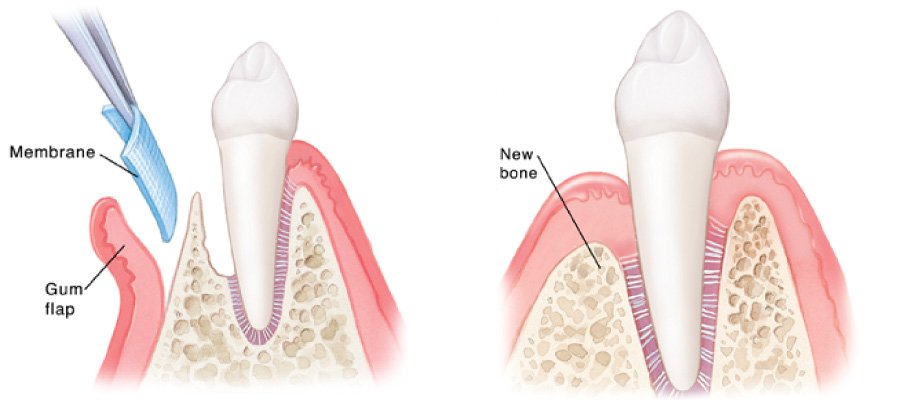Guided Tissue Regeneration
Home / Services / Guided Tissue Regeneration
Teeth are held in place by surrounding gums, bone, and other tissues. But periodontal disease can cause the bone to break down. Certain techniques called regenerative procedures can be used to stimulate growth of new bone. This growth increases the height of the bone around the tooth, giving the tooth more support, and increases the amount of attachment around the root of the tooth. Getting back even half the lost bone height extends the life of the tooth. One type of regenerative procedure is called guided tissue regeneration (GTR).
Guided tissue regeneration is a technique used to repair periodontal defects so that a tooth, or set of teeth, has more support and stability. Periodontal disease, or periodontitis, is a process where bacteria trapped under the gums leads to a chronic infection and subsequent breakdown of the hard and soft tissues supporting the teeth. In certain cases, the destruction leads to gaps that form between the teeth and bone. These gaps, or bony defects, often need a separate specialized procedure known as a bone graft. This is where special material is placed into the defect to promote new bone growth. Guided tissue regeneration uses a resorbable or nonresorbable artificial membranes to keep soft tissue from growing into these defective sites. This membrane is crucial because it blocks the faster migrating soft tissue cells from growing into the site, while allowing the slower migrating bone-producing cells to populate and grow there instead. This is how guided tissue regeneration is done:

Surgery on gum and bone. The gum is opened with a procedure known as a flap. The area under the gums is cleaned out to remove all bacterial deposits. Then a membrane (with or without the bone graft material) is placed over the damaged bone.
Separating tissues. Once in place between bone and gum, the membrane provides necessary space and time for the bone to heal and start regenerating itself.
After healing. The stitches and membrane dissolve or are removed. In about 6 months, new attachments and bone regenerate to support the tooth or teeth.
To decrease your chances of other health problems associated with periodontal disease, it is important to continue with your daily oral hygiene routine, along with professional maintenance care.
Guided tissue regeneration is a technique used to repair periodontal defects so that a tooth, or set of teeth, has more support and stability. Periodontal disease, or periodontitis, is a process where bacteria trapped under the gums leads to a chronic infection and subsequent breakdown of the hard and soft tissues supporting the teeth. In certain cases, the destruction leads to gaps that form between the teeth and bone. These gaps, or bony defects, often need a separate specialized procedure known as a bone graft. This is where special material is placed into the defect to promote new bone growth. Guided tissue regeneration uses a resorbable or nonresorbable artificial membranes to keep soft tissue from growing into these defective sites. This membrane is crucial because it blocks the faster migrating soft tissue cells from growing into the site, while allowing the slower migrating bone-producing cells to populate and grow there instead. This is how guided tissue regeneration is done:

Surgery on gum and bone. The gum is opened with a procedure known as a flap. The area under the gums is cleaned out to remove all bacterial deposits. Then a membrane (with or without the bone graft material) is placed over the damaged bone.
Separating tissues. Once in place between bone and gum, the membrane provides necessary space and time for the bone to heal and start regenerating itself.
After healing. The stitches and membrane dissolve or are removed. In about 6 months, new attachments and bone regenerate to support the tooth or teeth.
To decrease your chances of other health problems associated with periodontal disease, it is important to continue with your daily oral hygiene routine, along with professional maintenance care.
Let's Talk About Your Smile.
Our experienced team’s unique approach helps you take the first steps to optimal oral health.
Eastside Periodontics
Address: 13635 NE Bel-Red Rd, Bellevue, WA 98005Phone: (425) 643-5412
Email: eastsideperio@gmail.com
Office Hours
Monday 8:00 AM - 2:00 PMTuesday 7:00 AM - 5:00 PM
Wednesday 7:00 AM - 5:00 PM
Thursday 7:00 AM - 5:00 PM


